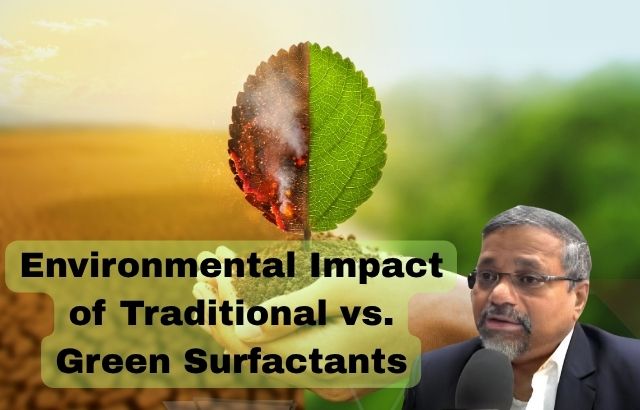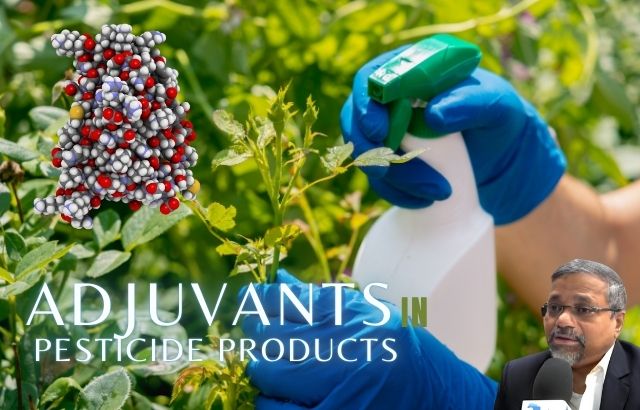The surfactant industry is undergoing a revolution—one that mirrors a broader shift towards sustainability and environmental responsibility across various sectors. For decades, surfactants, the key ingredients in detergents, shampoos, and countless other products, have been derived from petroleum-based sources. However, as environmental concerns escalate, both businesses and consumers are increasingly seeking out green alternatives.
But how do traditional surfactants stack up against their greener counterparts? And, more importantly, what role do these surfactants play in shaping our future environmental impact?
Let’s take a deep dive into the world of surfactants and explore the contrasting environmental effects of traditional vs. green surfactants.
What are Surfactants?
Before we get into the nitty-gritty of their environmental impact, let’s first understand what surfactants are and why they matter.
Surfactants are compounds that lower the surface tension between two substances, usually a liquid and a solid. They help ingredients mix more effectively in products like soaps, shampoos, and laundry detergents, allowing for better cleaning. They essentially enable oils, dirt, and grime to break down and wash away more easily.
While incredibly effective, the ingredients that make up traditional surfactants have a significant environmental footprint. In recent years, however, green surfactants have emerged as a cleaner alternative with less harmful effects on our planet.
The Environmental Impact of Traditional Surfactants

Traditional surfactants are typically made from petrochemicals, derived from fossil fuels. While they perform their cleaning duties efficiently, their production and disposal come with notable environmental costs.
- Toxicity to Aquatic Life:
Many conventional surfactants, such as alkylphenol ethoxylates (APEs), are toxic to aquatic life. Once washed down drains, they can accumulate in rivers, lakes, and oceans, harming fish and other organisms. These toxic effects are particularly concerning as aquatic ecosystems serve as the foundation of the global food chain. - Non-Biodegradability:
Some traditional surfactants take years to break down, meaning they linger in the environment long after their use. In contrast, green surfactants are typically biodegradable, breaking down quickly and safely without harming the ecosystem. - Higher Carbon Footprint:
The production of petrochemical surfactants is energy-intensive and contributes significantly to greenhouse gas emissions. As the world looks for ways to mitigate climate change, reducing carbon footprints in all industries—including the surfactant market—is more crucial than ever. - Chemical Pollution:
Aside from harming ecosystems, the chemicals in traditional surfactants can also pollute water sources, making it more difficult to treat and purify drinking water. The long-term consequences of this pollution are often underestimated.
Green Surfactants: The Eco-Friendly Alternative
In response to these environmental concerns, the industry has seen the rise of green surfactants—a cl
eaner, more sustainable option. Derived from natural, renewable resources like plant oils, sugars, and fatty acids, these eco-friendly surfactants are changing the game in both the personal care and cleaning industries.
- Biodegradable and Safe for Aquatic Life:
One of the most significant advantages of green surfactants is their biodegradability. Unlike traditional surfactants, which can take years to degrade, green surfactants break down quickly into non-toxic compounds, reducing their environmental impact. This makes them safer for aquatic life and ensures that they do not accumulate in our waterways. - Low Carbon Footprint:
Green surfactants are often produced using less energy and have a much lower carbon footprint than their traditional counterparts. Many are made from bio-based raw materials, which require fewer resources to produce and are much less reliant on fossil fuels. - Less Chemical Pollution:
Green surfactants generally contain fewer hazardous chemicals, reducing the risk of pollution and toxicity. This means less chemical contamination in water bodies and a reduced risk of harmful chemicals entering the food chain. - Sustainable and Renewable Ingredients:
The raw materials for green surfactants—such as palm kernel oil, coconut oil, and other plant-based sources—are renewable. Unlike petroleum-based surfactants, which rely on finite fossil fuels, green surfactants are derived from crops that can be replenished year after year, reducing dependency on non-renewable resources.
The Role of Researchers and Green Innovators in Surfacing Change

The shift from traditional surfactants to green alternatives has been largely driven by the research and innovation of scientists and green innovators. These experts are constantly searching for new bio-based feedstocks, sustainable production methods, and more effective formulations that minimize environmental harm.
- Researchers:
Researchers in academia and the private sector play a vital role in developing new green surfactants and improving the performance of existing ones. They explore plant-based materials, algae, and other renewable resources to find eco-friendly alternatives that work just as well, if not better, than conventional surfactants. - Green Innovators:
Green innovators focus on pushing the boundaries of sustainability, creating solutions that are as effective as they are environmentally responsible. They work on formulating eco-friendly surfactants that meet the growing consumer demand for sustainable products while keeping costs manageable for manufacturers.
Challenges and Future of Green Surfactants
While green surfactants offer clear advantages, they are not without their challenges:
- Higher Initial Costs:
Due to the sourcing of renewable raw materials and more complex production processes, green surfactants can be more expensive than their traditional counterparts. However, as demand increases and technology improves, these costs are expected to decrease over time. - Limited Availability:
While the market for green surfactants is growing, the availability of sustainable raw materials can be limited, especially when compared to the widespread use of petroleum-derived ingredients. More investment in sustainable agriculture and sourcing is needed to scale up production. - Formulation Adjustments:
Switching to green surfactants may require businesses to reformulate existing products, ensuring that they meet the same performance standards as traditional products. While this may pose an initial hurdle, it presents an opportunity for innovation.
FAQs on the Environmental Impact of Traditional vs. Green Surfactants

1. What are surfactants, and why are they important?
Surfactants are chemicals that reduce surface tension between liquids, making them essential in cleaning, personal care, and industrial products. They help improve the performance of products like detergents, shampoos, and soaps.
2. What is the difference between traditional surfactants and green surfactants?
Traditional surfactants are typically derived from petrochemicals and can have harmful environmental effects. Green surfactants, on the other hand, are plant-based or derived from renewable resources, offering a more eco-friendly alternative.
3. How do traditional surfactants affect the environment?
Traditional surfactants often contain toxic ingredients that can harm aquatic life, cause water pollution, and take a long time to biodegrade. Their production also tends to have a higher carbon footprint.
4. Are green surfactants truly eco-friendly?
Yes, green surfactants are made from renewable resources, biodegradable, and have a significantly lower environmental impact compared to traditional options. However, their environmental benefits depend on sustainable sourcing and production processes.
5. Why are green surfactants considered more sustainable?
Green surfactants are biodegradable, have fewer toxic byproducts, and come from renewable resources. Their production processes generally involve lower energy consumption and generate fewer harmful emissions.
6. Can green surfactants be used in the same applications as traditional ones?
Yes, green surfactants are versatile and can replace traditional surfactants in various applications, including household cleaners, personal care products, and industrial processes. They are just as effective, if not more, depending on the formulation.
7. Are green surfactants more expensive than traditional ones?
While green surfactants can sometimes be more expensive due to sourcing and production methods, their long-term environmental benefits often outweigh the costs. Many companies are also adopting them to meet sustainability goals.
8. How can businesses transition to using green surfactants?
Businesses can start by evaluating their current products, identifying opportunities for eco-friendly alternatives, and sourcing green surfactants from suppliers who prioritize sustainability. Formulating products with green surfactants can boost brand reputation and attract eco-conscious consumers.
9. What are the challenges of switching to green surfactants?
Challenges include higher initial costs, limited availability, and potential formulation adjustments. However, with increasing demand for sustainable products, these challenges are becoming more manageable as the market for green surfactants grows.
10. Are there certifications or standards for green surfactants?
Yes, several certifications, such as EcoCert, USDA Organic, and the European Ecolabel, ensure that green surfactants meet specific environmental and sustainability standards. Look for these certifications when choosing green surfactants for your products.
11. What role do researchers play in the development of green surfactants?
Researchers are crucial in the development of green surfactants. They study and innovate new ways to derive surfactants from renewable resources, ensuring that these alternatives are not only effective but also environmentally sustainable. By exploring bio-based feedstocks and testing their environmental impact, researchers drive the shift from harmful chemicals to safer, greener solutions.
12. How do green innovators contribute to the surfactant industry?
Green innovators are pioneers in designing more sustainable, efficient, and eco-friendly surfactant solutions. They lead the charge by pushing boundaries in material science, discovering new natural sources, and refining production processes to lower carbon footprints. Their work ensures that the surfactant industry aligns with global environmental goals and consumer demands for sustainability.
Conclusion: The Green Wave is Here
The environmental impact of traditional surfactants is undeniable, but the emergence of green surfactants presents a promising solution. As the demand for sustainable and eco-friendly products grows, so too does the potential for green surfactants to replace harmful traditional alternatives across industries.
With the support of researchers, green innovators, and environmentally conscious businesses, the shift towards greener surfactants is not only possible but imperative. It’s clear that the eco-wave is here, and it’s gaining momentum—paving the way for a cleaner, more sustainable future for generations to come.
By embracing green surfactants, we can clean up our act, protect the planet, and continue to enjoy the benefits of effective, eco-friendly cleaning products. The choice is ours—let’s ride the wave of change together.












